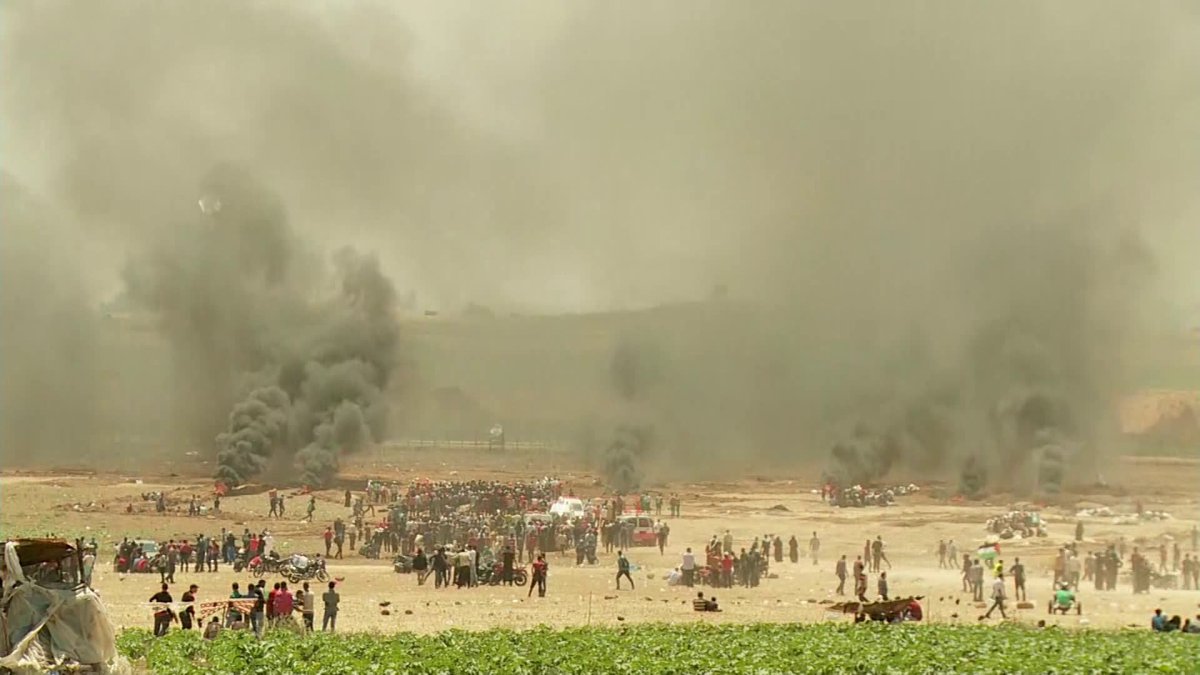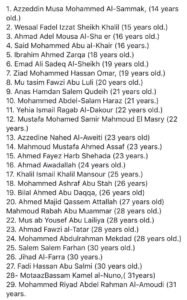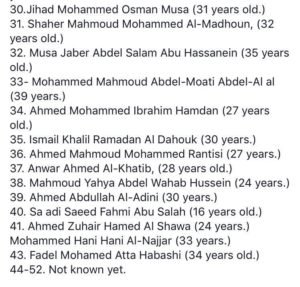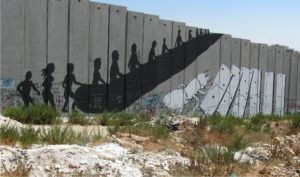Killing Gaza

May 14, 2018
by Chris Hedges
WASHINGTON, D.C.—Israel’s blockade of Gaza—where trapped Palestinians for the past seven weeks have held nonviolent protests along the border fence with Israel, resulting in scores of dead and some 6,000 wounded by Israeli troops—is one of the world’s worst humanitarian disasters. Yet the horror that is Gaza, where 2 million people live under an Israeli siege without adequate food, housing, work, water and electricity, where the Israeli military routinely uses indiscriminate and disproportionate violence to wound and murder, and where almost no one can escape, is rarely documented. Max Blumenthal and Dan Cohen’s powerful new film, “Killing Gaza,” offers an unflinching and moving portrait of a people largely abandoned by the outside world, struggling to endure.
“Killing Gaza” will be released Tuesday, to coincide with what Palestinians call Nakba Day—“nakba” means catastrophe in Arabic—commemorating the 70th anniversary of the forced removal of some 750,000 Palestinians in 1948 by the Haganah, Jewish paramilitary forces, from their homes in modern-day Israel. The release of the documentary also coincides with the Trump administration’s opening of the new U.S. Embassy in Jerusalem.
Because of Nakba Day and the anger over the transfer of the embassy to Jerusalem, this week is expected to be one of the bloodiest of the seven-week-long protest that Palestinians call the “Great Return March.” “Killing Gaza” illustrates why Palestinians, with little left to lose, are rising up by the thousands and risking their lives to return to their ancestral homes—70 percent of those in Gaza are refugees or the descendants of refugees—and be treated like human beings.
Cohen and Blumenthal, who is the author of the book “Goliath: Life and Loathing in Greater Israel,” one of the best accounts of modern Israel, began filming the documentary Aug. 15, 2014. Palestinian militias, armed with little more than light weapons, had just faced Israeli tanks, artillery, fighter jets, infantry units and missiles in a 51-day Israeli assault that left 2,314 Palestinians dead and 17,125 injured. Some 500,000 Palestinians were displaced and about 100,000 homes were destroyed or damaged. The 2014 assault, perhaps better described as a massacre, was one of eight massacres that Israel has carried out since 2004 against the 2 million Palestinians in Gaza, over half of whom are children. Israel, which refers to these periodic military assaults as “mowing the lawn,” seeks to make existence in Gaza so difficult that mere survival consumes most of the average Palestinian’s time, resources and energy.
The film begins in the Shuja’iyya neighborhood, reduced to mounds of rubble by the Israelis. The wanton destruction of whole neighborhoods was, as documented by the film, accompanied by the shooting of unarmed civilians by Israeli snipers and other soldiers of that nation.
“Much of the destruction took place in the course of a few hours on July 23,” Blumenthal, who narrates the film, says as destroyed buildings appear on the screen, block after block. “The invading Israeli forces found themselves under ferocious fire from local resistance forces, enduring unexpectedly high casualties. As the Israeli infantry fled in full retreat, they called in an artillery and air assault, killing at least 120 Palestinian civilians and obliterated thousands of homes.”
The film includes a brief clip of young Israelis in Tel Aviv celebrating the assault on Gaza, a reminder that toxic racism and militarism infect Israeli society.
“Die! Die! Bye!” laughing teenage girls shout at the celebration in Tel Aviv. “Bye, Palestine!”
“Fucking Arabs! Fuck Muhammad!” a young man yells.
“Gaza is a graveyard! Gaza is a graveyard! Ole, ole, ole, ole,” the crowd in Tel Aviv sings as it dances in jubilation. “There is no school tomorrow! There are no children left in Gaza!”
Terrified Palestinian families huddled inside their homes as Israel dropped more than 100 one-ton bombs and fired thousands of high-explosive artillery shells into Shuja’iyya. Those who tried to escape in the face of the advancing Israelis often were gunned down with their hands in the air, and the bodies were left to rot in the scorching heat for days.
“I was inside when they started bulldozing my house,” Nasser Shamaly, a Shuja’iyya resident, says in the film. “They took down the wall and started shooting into the house. So I put my hands on my head and surrendered myself to the officer. This wasn’t just any soldier. He was the officer of the group! He didn’t say a word. He just shot me. I fell down and started crawling to get away from them.”
Shamaly, who hid wounded in his house for four days, was fortunate. His 23-year-old cousin, Salem Shamaly, who led a group of volunteers from the International Solidarity Movement to dig bodies out of the ruins in Shuja’iyya, was not.
“On the offensive’s 14th day, July 20th, 2014, four other activists and I went to the Shuja’iyya neighborhood, which Israel had bombed for days, to accompany rescue teams in the rubble during the two-hour cease-fire,” Joe Catron, one of the members of the International Solidarity Movement rescue team, says in the film. “A young Palestinian, whose name we later learned was Salem Shamaly, asked us to go with him to his house, where he hoped to find his family. It sounds ridiculous now, but at the time we thought the cease-fire would make it safe.”
“As we crossed an alley with a clear line of sight to Israeli positions by the separation barrier, a gunshot from their direction struck the ground between us. We scattered into two groups, sheltered behind buildings on either side. After a pause, Salem stepped into the alley, hoping to lead his group to our side, but was struck by another bullet. He fell to the ground.”
The film shows Shamaly wounded on the ground, barely able to move and crying out in pain.
“As he lay on his back, two more rounds hit him,” Catron continued. “He stopped moving. The gunfire kept us from reaching him. The Israeli artillery began flying overhead and striking the buildings behind us. We were forced to retreat, leaving him. We only learned his name two days later, when his mother, father, sister and cousin recognized him in a video I had tweeted.”
“We couldn’t retrieve his body for seven days,” Um Salem, the mother, says in the film. “His body was in the sun for seven days.”
Waseem Shamaly, Salem’s brother, who appears to be about 8 years old, is shown with his eyes swollen from crying. “He would take care of us, like our father,” the boy says. “Even at night, he would get us whatever we wanted. He used to buy us everything. Whatever we wished for, he would buy it. There was nothing he wouldn’t buy for us. He used to take us to hang out. He’d take us out with him just to kill our boredom a little.”
Waseem wipes his eyes.
“Now he is gone,” he continues weakly. “There is nobody to take us out and buy us treats.”
“This boy hasn’t been able to handle losing his brother,” says the father, Khalil Shamaly. “He couldn’t handle the news, seeing the way his brother died. He is in shock. It gets to the point where he goes lifeless. He collapses. When I pick him up he tells me his dying wishes. His dying wishes! As if he is leaving us. He is so young. But he gives us his dying wishes. If it weren’t for God’s mercy, I would have lost him too.”
“Destroyed cities and shattered homes can be rebuilt if the resources are there,” Blumenthal says. “But what about the survivors? How can they heal the scars imposed on their psyches? The youth of Gaza has grown up through three wars, each more devastating than the last. At least 90 percent of adolescents in Gaza suffer from post-traumatic stress disorder. With mental health services pushed to the brink, these unseen scars may never heal.”
The film turns to the town of Khuza’a, a farming community with 20,000 people, which was systematically blown up by Israel after three Israeli soldiers were killed in fighting with the al-Qassam Brigades, the armed wing of the ruling Hamas government in Gaza. The film shows a video from inside an Israeli tank as soldiers wait for explosives to bring down buildings in the town, including the mosque. When the explosions occur, the Israeli soldiers cheer and shout, “Long live the state of Israel!”
Starting Tuesday, May 15, “Killing Gaza” can be seen at Vimeo On Demand.
“We were shocked to see so many bodies in the streets,” Ahmed Awwad, a volunteer with the Palestinian Red Crescent, says in the film about Khuza’a. “Many were decomposing. We wanted to deal with it, but we didn’t know how. Once, when the Israelis let us in with our ambulance, we found about 10 corpses from different areas, scattered. As you approached a body, of course there is the odor, and there are worms. Hold it like this, and flesh comes off. Lift an arm and it pulls right off. We didn’t know what to do. There was nothing we could do. We had to stop. It would have been easier just to bury them. But we figured families would want the bodies. Bulldozers eventually loaded the bodies in trucks. We couldn’t pick up these bodies on our own. Most were executions, like an old lady at her front door. There was a young man, another man, and a little kid. The scenes, to be honest, were very ugly.”
The Rjeila family, including 16-year-old Ghadeer, who was physically disabled, attempts to escape the shelling. As a brother frantically pushes Ghadeer in her wheelchair (the scene, like several others in the film, is reconstructed through animation), the Israelis open fire. The brother is wounded. Ghadeer is killed.
The camera pans slowly through demolished houses containing blackened human remains. Walls and floors are smeared with blood.
Ahmed Awwad, a Palestinian Red Crescent volunteer, describes what happened after he and other volunteers finally receive permission from Israeli forces to retrieve bodies from Khuza’a. They find a man tied to a tree and shot in both legs. One of the volunteers, Mohammed al-Abadla, gets out of a vehicle and approaches the tree. When he switches on his flashlight, which the Israelis had instructed him to do, he is shot in heart and killed.
“For 51 days, Israel bombarded Gaza with the full might of its artillery,” Blumenthal says. “According to the Israeli military’s estimates, 23,410 artillery shells and 2.9 million bullets were fired into Gaza during the war.”
That’s one and a half bullets for every man, woman and child in the Gaza Strip.
There is footage of Israeli soldiers in an artillery unit writing messages, including “Happy Birthday to Me,” on shells being lobbed into Gaza. The soldiers laugh and eat sushi as they pound Palestinian neighborhoods with explosives.
Rafah is a city in Gaza on the border of Egypt. The film makes it clear that Egypt, through its sealing of Gaza’s southern border, is complicit in the blockade. Rafah was one of the first cities targeted by the Israelis. When Israeli troops took over buildings, they also kidnapped Palestinians and used them as human shields there and elsewhere, forcing them to stand at windows as the soldiers fired from behind.
“They blindfolded and handcuffed me and took me inside,” Mahmoud Abu Said says in the film. “They told me to come with them and put a M16 to my back. There were maybe six of them. They dropped their equipment and began searching. They started hitting me against the wall. And then sicced their dogs on me while I was handcuffed.”
“They put me here,” he says, standing in front of a window, “and stood behind me. Israeli soldiers placed me here while they stood behind me shooting. They took me to that window and that window too. Then they hit me against the wall and pushed me down. They put a mattress here,” he says, showing holes punched through the wall at floor level, “and sat down to shoot through these holes.”
“You see that car?” asks Suleiman Zghreibv, referring to a hunk of twisted metal that lies next to the ruins of his house. “He drove it,” he says of his 22-year-old son, who was executed by the Israelis. “This is the car we used to make our living. It wasn’t for personal use. It was a taxi. I can’t describe the suffering. What can I say? Words can’t express the pain. We have suffered and resisted for so long. We’ve been suffering our whole lives. We’ve suffered for the past 60 years because of Israel. War after war after war. Bombing after bombing after bombing. You build a house. They destroy it. You raise a child. They kill him. Whatever they do—the United States, Israel, the whole world, we’ll keep resisting until the last one of us dies.”
Israel intentionally targeted power plants, schools, medical clinics, apartment complexes, whole villages. Robert Piper, the United Nations Coordinator for Humanitarian Aid and Development Activities, said in 2017 that Gaza had “a long time ago” passed the “unlivability threshold.” Youth unemployment is at 60 percent. Suicide is epidemic. Traditional social structures and mores are fracturing, with divorce rising from 2 percent to 40 percent and girls and women increasingly being prostituted, something once seen only rarely in Gaza. Seventy percent of the 2 million Gazans survive on humanitarian aid packages of sugar, rice, milk and cooking oil. The U.N. estimates that 97 percent of Gaza’s water is contaminated. Israel’s destruction of Gaza’s sewage treatment plant means raw sewage is pumped into the sea, contaminating the beach, one of the very few respites for a trapped population. The Israelis did not even spare Gaza’s little zoo, slaughtering some 45 animals in the 2014 assault.
“I liked the monkeys best,” says a forlorn Ali Qasem, who worked at the zoo. “We laughed with them the most. We would laugh and play with them. They would take food right from your hand. They’d respond the most. There is a heavy feeling of sorrow. I used to spend 18 hours a day here. I was here all the time. I’d go home for five or six hours, then come back. I worked here as a volunteer. A few volunteers built this place little by little. We were excited to finish and invite visitors for free. To me, it was like humans were killed. It’s not OK because they were animals. It’s as if they were human beings, people we know. We used to bring them food from our homes.”
The film shows Palestinians, who have received little reconstruction aid despite pledges by international donors, camping out amid the ruins of homes, gathered around small fires for heat and light. Moeen Abu Kheysi, 54, gives a tour of the smashed house he had spent his life constructing for his family. He stops when he comes upon his 3-month-old grandson, Wadie. His face lights up in delight.
“Months passed and the cold rains of winter gave way to baking heat of spring,” Blumenthal says. “In Shuja’iyya, the Abu Kheysi family was still living in remnants of their home, but without their newest member. Born during the war, little Wadie did not make it through the harsh winter.”
“He was born during the war and he died during the war, well after the war,” a female member of the family explains. “He lived in a room without a wall. We covered the wall with tin sheets. We moved, but then we got kicked out. We couldn’t make rent. [We] had to come back, cover the wall and live here. Then the baby froze to death. It was very cold.”
“One day it suddenly became very cold,” Wadie’s mother says. “Wadie woke up at 9 in the morning. I started playing with him, gave him a bottle. Suddenly, he was shivering from the cold. I tried to warm him up but it wasn’t working.”
She begins to weep.
“There wasn’t even time to get to the hospital,” she says. “He stopped breathing before they left the house. His heart stopped beating instantly. His father started running in the street with him. He fainted when they yelled, “The baby is dead!” The baby’s uncle took over and carried him. He looked everywhere for a taxi but couldn’t find one. We couldn’t give him first aid ourselves. They finally found a car. They did all they could at the hospital, but he never woke up. He was dead. What can I say? We remember him all the time. I can’t get him off my mind. It’s as if I lost a piece of my heart. His sisters want to sleep in his cradle and wear his clothes. This one always asks to wear her brother’s clothes. We can’t forget him.”
“Grandpa!” Wadie’s small sister cries out. “Mama is crying again.”
Chris Hedges, spent nearly two decades as a foreign correspondent in Central America, the Middle East, Africa and the Balkans. He has reported from more than 50 countries and has worked for The Christian Science Monitor, National Public Radio, The Dallas Morning News and The New York Times, for which he was a foreign correspondent for 15 years. https://www.truthdig.com/author/chris_hedges/
Source: Killing Gaza
**
Chris Hedges on the Gaza Massacre - It is not a war. It is murder
Chris Hedges, author, spoke at a Revolution Books Town Hall Meeting at Ethical Culture Society January 13, 2009 condemning Israel and US complicity in Israel's murderous destruction of Gaza.
Watch the video on Vimeo: Chris Hedges on the Gaza Massacre - It is not a war. It is murder
Names of Palestinians Slaughtered Yesterday

See also: Living in an Open Air Prison
For more tyranny please visit: https://www.OpDeepState.com


I don't know why Trump thinks it's his right to declare other countries capitals, Bit like Kim Jong Un declaring Dallas the capital of Mexico really.